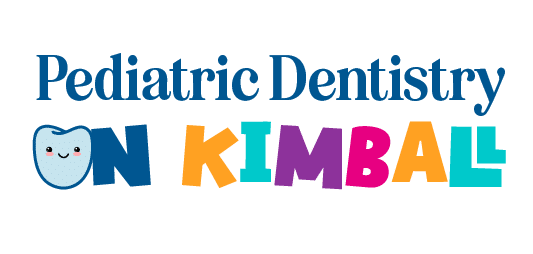At Pediatric Dentistry on Kimball, we know that seeing stains or discoloration on your child’s teeth can be concerning. Our mission is to help families in Brooklyn understand what these changes mean, how to prevent them, and when it’s time to see a pediatric dentist.
Baby teeth stains can appear for many reasons, from simple plaque buildup to early enamel changes, and most causes are treatable with professional care. Dr. Lionel Vera, a board-certified pediatric dentist, and his team combine modern tools, gentle techniques, and education to make every visit positive and anxiety-free for your child.
This Article will address:
- What causes baby teeth stains or discoloration
- How to reverse brown spots on baby teeth
- How to remove yellow stains from baby teeth
- Why cavities sometimes look black
- How to clean plaque from a 1-year-old’s teeth
- When to see a dentist for discoloration
- How to prevent future staining
- Treatment options available at Pediatric Dentistry on Kimball
What Causes Baby Teeth Stains or Discoloration?
Understanding why baby teeth change color helps parents respond quickly and effectively. In most cases, discoloration falls into one of two categories:
- Extrinsic Stains develop on the surface of the tooth. They’re often caused by plaque buildup, inadequate brushing, or foods and drinks with strong pigments such as berries or juices. Iron supplements can also leave dark residue.
- Intrinsic Stains occur within the tooth structure and may stem from developmental enamel defects, certain medications, or trauma to a baby tooth.
Occasionally, excessive fluoride or illness during tooth formation can affect color. If a stain doesn’t brush away or darkens over time, it’s best to have it examined. Early evaluation ensures that small concerns don’t lead to future cavities.
Can You Reverse Brown Spots on Baby Teeth?
Brown spots on baby teeth are often one of the first visible signs of early decay or long-term plaque accumulation. While mild surface discoloration can sometimes be improved with professional cleaning or fluoride treatment, deeper brown areas may signal weakened enamel.
At Pediatric Dentistry on Kimball, Dr. Vera evaluates these spots carefully to determine whether they’re stains or the beginning of a cavity. If the enamel is damaged, we may recommend a gentle restoration or remineralization treatment to protect the tooth.
Parents should avoid over-the-counter whitening products, which can harm sensitive enamel. The safest and most effective way to restore brightness is through professional pediatric care.
How to Get Yellow Stains Off Baby Teeth
Yellow discoloration is usually linked to plaque buildup, dietary choices, or the natural shade of enamel. Fortunately, yellow stains are often reversible with consistent home and professional care.
Simple steps to reduce yellow stains:
- Brush twice daily with a soft-bristled toothbrush and a rice-sized amount of fluoride toothpaste for children under three.
- Limit sugary foods and colored beverages. Encourage water between meals.
- Schedule regular professional cleanings every six months.
- Ask about fluoride varnish to strengthen developing enamel.
Professional polishing removes surface stains safely, while education helps families maintain healthy habits between visits.
What Is the Black Stuff on Kids’ Cavities?
When parents notice black or dark brown spots, it can be alarming. This discoloration often indicates tooth decay, where bacteria and minerals have darkened the enamel. In some cases, it’s caused by iron supplements or naturally occurring chromogenic bacteria, which produce darker pigment.
Regardless of the cause, these stains deserve attention. Without treatment, decay can spread and affect surrounding teeth. Dr. Vera uses diagnostic imaging and gentle techniques to pinpoint the problem early and restore your child’s smile comfortably. For children who feel anxious, we offer Nitrous Oxide (“laughing gas”) to make the experience calm and relaxed.
How to Get Plaque Off My 1-Year-Old’s Teeth
Even before all baby teeth appear, oral care plays a key role in long-term dental health. To safely remove plaque and residue from a baby’s mouth:
- Begin brushing once the first tooth appears using a small, soft brush or finger brush.
- Avoid bottles or breastfeeding right before sleep, as leftover milk or formula can sit on the teeth overnight.
- Clean gums and early teeth gently after each feeding.
- Schedule your child’s first dental visit by age one for personalized guidance.
Dr. Vera and his team focus on parent education during these early appointments. We show caregivers exactly how to brush and monitor for signs of early decay, building confidence and healthy habits from the start.
When Should I See a Dentist About Baby Teeth Stains?
Not every discoloration is an emergency, but certain changes warrant prompt attention. Contact our office if:
- Stains don’t improve with brushing.
- A tooth turns brown, gray, or black.
- Your child experiences pain, sensitivity, or swelling.
At Pediatric Dentistry on Kimball, we offer same-day and emergency appointments for situations that can’t wait. Addressing issues early helps preserve your child’s comfort and confidence.
How to Prevent Future Staining
Daily Home Care
- Brush twice daily with fluoride toothpaste.
- Floss once teeth begin touching.
- Offer water between meals and avoid sticky snacks.
Regular Dental Visits
- Schedule professional cleanings every six months.
- Ask about fluoride varnish and sealants for added protection.
- Discuss your child’s brushing technique during each visit.
What Not to Do
- Avoid whitening toothpaste or home whitening kits for children.
- Do not scrape or scrub stains with abrasive tools.
- Skip home remedies like baking soda or acidic rinses, which can damage enamel.
Age-Specific Considerations for Stains
|
Age Group |
Common Causes of Stains |
Recommended Action |
|
Milk residue, bottle use, medications |
Wipe teeth and gums after feedings |
|
|
Toddlers |
Plaque buildup, new diet, early decay |
Brush twice daily, limit sugary foods |
|
School-Age |
Sports drinks, poor brushing, trauma |
Regular cleanings and fluoride |
|
Teens |
Braces, whitening interest, dietary stains |
Professional guidance on safe whitening options |
Treatment Options at Pediatric Dentistry on Kimball
Our Brooklyn office is equipped to manage all types of pediatric discoloration and early decay. We offer:
- Gentle professional cleanings to remove buildup and restore shine.
- Fluoride varnish and sealants to protect developing enamel.
- Early cavity detection and restorations to stop decay in its tracks.
- Nitrous oxide sedation for anxious patients.
- Ongoing parent and child education to promote lifelong oral health.
These services reflect our commitment to a comfortable, educational experience in a warm, supportive setting.
Trusted Pediatric Dental Care for Growing Smiles in Brooklyn
At Pediatric Dentistry on Kimball, we believe every child deserves a confident, healthy smile. If you’ve noticed spots or discoloration on your child’s teeth, we’re here to help. Our Brooklyn, NY office provides compassionate, professional care tailored to each child’s needs, with flexible after-school and weekend hours.
Call us today or schedule your appointment online to restore your child’s bright, healthy smile.
Sources
- Mayo Clinic – Discolored baby teeth: A cause for concern?
- American Academy of Pediatric Dentistry – Guideline on Fluoride Therapy
- American Dental Association – Healthy Habits for Children

Dr. Lionel Vera
Dr. Lionel Vera brings warmth, expertise, and advocacy to Pediatric Dentistry on Kimball as a board-certified pediatric dentist. He earned his dental degree from the University of Puerto Rico, Medical Science Campus, followed by a residency at Kingsbrook Jewish Medical Center, where he honed his skills with children and special needs patients. A Brooklyn-based pediatric dentist since 2018, Dr. Vera blends compassionate care with a strong focus on educating both children and parents about oral health. Dr. Vera’s mission: to inspire a lifetime of healthy smiles through trust, education, and proactive care.

